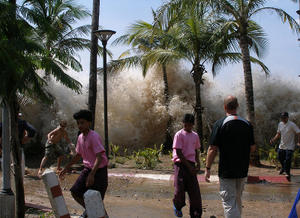DisastersBetter understanding of how tsunamis work
One of the obstacles to understanding how tsunamis work is the notion that it is the first wave that is the worst; researchers show that this is not the case, and that the second, third, or even fourth wave are often the most destructive

Tsunami closes inland in 2004 // Source: aps.org
Tsunamis occur so infrequently, more often than not in areas where they are not recorded very well, so scientists have been working with only little information in trying to understand how tsunamis work once they reach shore. Now, Frederic Dias from University College in Dublin and his team of mathematical and computer scientists have developed a computer simulation that they believe explains how tsunamis work once they reach shore. They have described their findings in Physical Review Letters.
Physical Review Focus reports that scientists have typically been able to emulate how a tsunami starts, and also how it travels across vast ocean distances. What scientists have not been able to do is mimic how tsunamis behave once they reach the shore, which is where they cause damage and loss of life. One of the obstacles to understanding how tsunamis work is the notion that it is the first wave that is the worst.
Dias and colleagues show with their model that this is not generally the case. They say that the second, third, or even fourth wave are often the worst because when the first wave hits it goes up on shore as far as its energy will carry it, then recedes back into the ocean. When it recedes, it carries with it some energy, so that it does not just ebb back into the ocean. Rather, it recedes far out to sea, which means that it has considerable potential energy in it. As is the case with a pendulum, it has to move back toward the shore – in the process adding its own energy to that of the next tsunami wave. This combined energy of both waves will cause the next wave to run both higher up into the air (the run-up) and farther up the shore (inundation).
One of the important variables is the slope of the ocean floor leading up to the shoreline. If there is a long, moderate slope, the energy of the wave will be spread out, resulting in a low run-up. If the ocean floor has a sudden, steep climb just as it reaches shore, all that energy in the wave has nowhere to go but up, creating an enormous run-up with devastating effects.
Another variable is the shore itself. Loose ground might create landslides that can work the same way as the waves themselves, adding potential energy to the mix.
PRF notes that when Dias and his team added parameters to their model to mimic actual tsunamis, they found results that appeared to coincide with what had actually occurred, giving more credence to their findings. They are not suggesting, however, that their model answers all the questions oceanographers have about tsunamis, but their helps in better understanding of tsunamis.
— Read more in Themistoklis S. Stefanakis and Frédéric Dias, “Local Run-Up Amplification by Resonant Wave Interactions,” Physical Review Letters 107, no. 12 (16 September 2011) (DOI:10.1103/PhysRevLett.107.124502)
